Yuandong Tian
Deep Contrastive Learning is Provably (almost) Principal Component Analysis
Jan 29, 2022


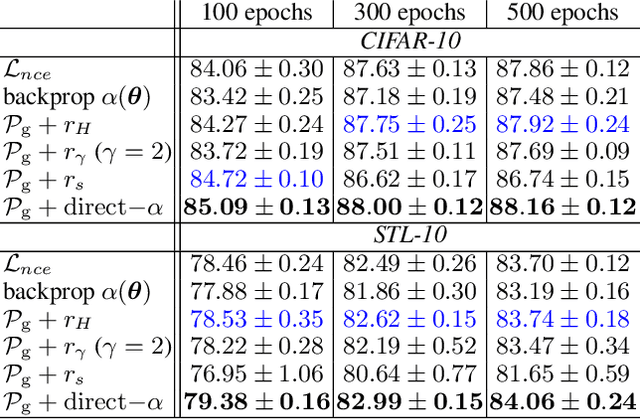
Abstract:We show that Contrastive Learning (CL) under a family of loss functions (including InfoNCE) has a game-theoretical formulation, where the \emph{max player} finds representation to maximize contrastiveness, and the \emph{min player} puts weights on pairs of samples with similar representation. We show that the max player who does \emph{representation learning} reduces to Principal Component Analysis for deep linear network, and almost all local minima are global, recovering optimal PCA solutions. Experiments show that the formulation yields comparable (or better) performance on CIFAR10 and STL-10 when extending beyond InfoNCE, yielding novel contrastive losses. Furthermore, we extend our theoretical analysis to 2-layer ReLU networks, showing its difference from linear ones, and proving that feature composition is preferred over picking single dominant feature under strong augmentation.
Learning Bounded Context-Free-Grammar via LSTM and the Transformer:Difference and Explanations
Dec 16, 2021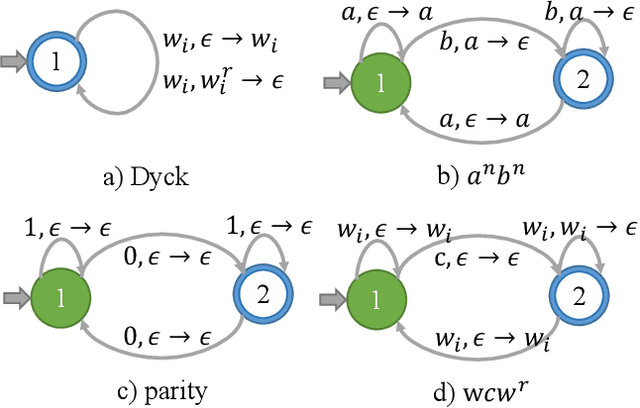


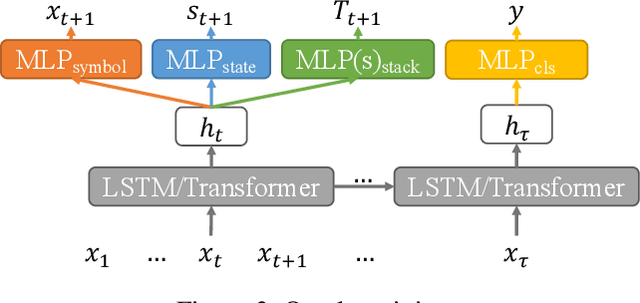
Abstract:Long Short-Term Memory (LSTM) and Transformers are two popular neural architectures used for natural language processing tasks. Theoretical results show that both are Turing-complete and can represent any context-free language (CFL).In practice, it is often observed that Transformer models have better representation power than LSTM. But the reason is barely understood. We study such practical differences between LSTM and Transformer and propose an explanation based on their latent space decomposition patterns. To achieve this goal, we introduce an oracle training paradigm, which forces the decomposition of the latent representation of LSTM and the Transformer and supervises with the transitions of the Pushdown Automaton (PDA) of the corresponding CFL. With the forced decomposition, we show that the performance upper bounds of LSTM and Transformer in learning CFL are close: both of them can simulate a stack and perform stack operation along with state transitions. However, the absence of forced decomposition leads to the failure of LSTM models to capture the stack and stack operations, while having a marginal impact on the Transformer model. Lastly, we connect the experiment on the prototypical PDA to a real-world parsing task to re-verify the conclusions
Dynamic Graph Representation Learning via Graph Transformer Networks
Nov 19, 2021
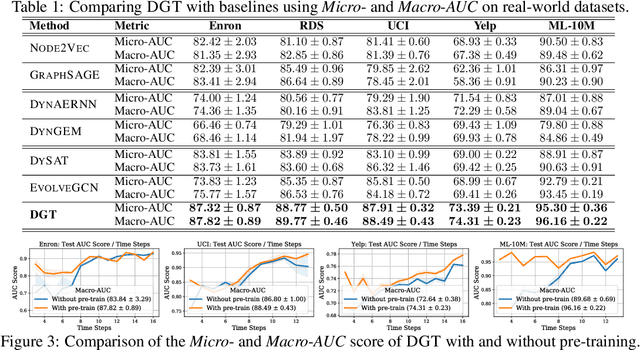

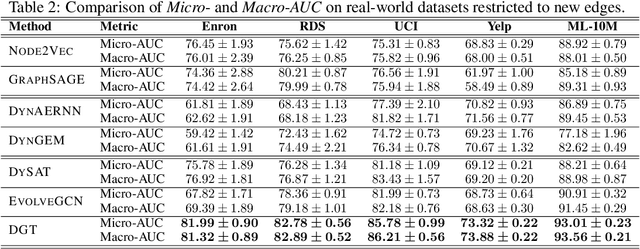
Abstract:Dynamic graph representation learning is an important task with widespread applications. Previous methods on dynamic graph learning are usually sensitive to noisy graph information such as missing or spurious connections, which can yield degenerated performance and generalization. To overcome this challenge, we propose a Transformer-based dynamic graph learning method named Dynamic Graph Transformer (DGT) with spatial-temporal encoding to effectively learn graph topology and capture implicit links. To improve the generalization ability, we introduce two complementary self-supervised pre-training tasks and show that jointly optimizing the two pre-training tasks results in a smaller Bayesian error rate via an information-theoretic analysis. We also propose a temporal-union graph structure and a target-context node sampling strategy for efficient and scalable training. Extensive experiments on real-world datasets illustrate that DGT presents superior performance compared with several state-of-the-art baselines.
Understanding Dimensional Collapse in Contrastive Self-supervised Learning
Oct 18, 2021

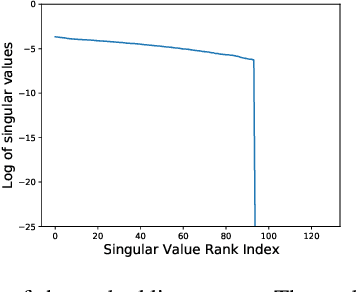
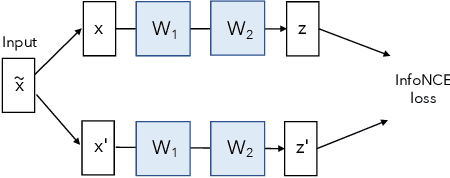
Abstract:Self-supervised visual representation learning aims to learn useful representations without relying on human annotations. Joint embedding approach bases on maximizing the agreement between embedding vectors from different views of the same image. Various methods have been proposed to solve the collapsing problem where all embedding vectors collapse to a trivial constant solution. Among these methods, contrastive learning prevents collapse via negative sample pairs. It has been shown that non-contrastive methods suffer from a lesser collapse problem of a different nature: dimensional collapse, whereby the embedding vectors end up spanning a lower-dimensional subspace instead of the entire available embedding space. Here, we show that dimensional collapse also happens in contrastive learning. In this paper, we shed light on the dynamics at play in contrastive learning that leads to dimensional collapse. Inspired by our theory, we propose a novel contrastive learning method, called DirectCLR, which directly optimizes the representation space without relying on a trainable projector. Experiments show that DirectCLR outperforms SimCLR with a trainable linear projector on ImageNet.
Towards Demystifying Representation Learning with Non-contrastive Self-supervision
Oct 11, 2021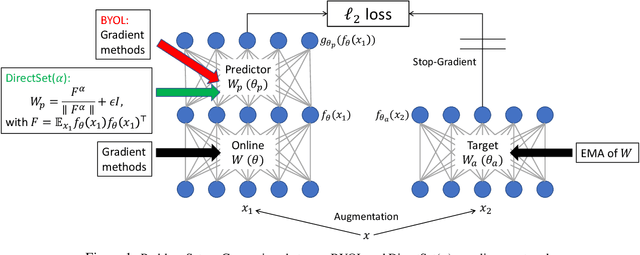
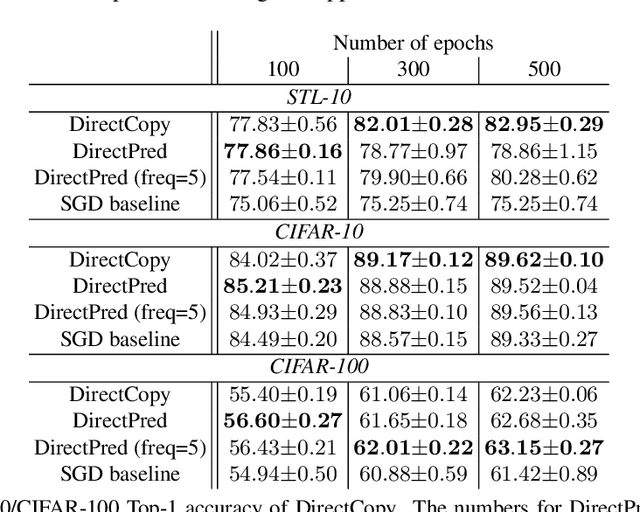
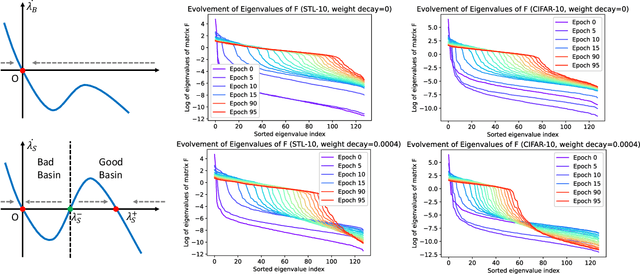

Abstract:Non-contrastive methods of self-supervised learning (such as BYOL and SimSiam) learn representations by minimizing the distance between two views of the same image. These approaches have achieved remarkable performance in practice, but it is not well understood 1) why these methods do not collapse to the trivial solutions and 2) how the representation is learned. Tian el al. (2021) made an initial attempt on the first question and proposed DirectPred that sets the predictor directly. In our work, we analyze a generalized version of DirectPred, called DirectSet($\alpha$). We show that in a simple linear network, DirectSet($\alpha$) provably learns a desirable projection matrix and also reduces the sample complexity on downstream tasks. Our analysis suggests that weight decay acts as an implicit threshold that discard the features with high variance under augmentation, and keep the features with low variance. Inspired by our theory, we simplify DirectPred by removing the expensive eigen-decomposition step. On CIFAR-10, CIFAR-100, STL-10 and ImageNet, DirectCopy, our simpler and more computationally efficient algorithm, rivals or even outperforms DirectPred.
Multi-objective Optimization by Learning Space Partitions
Oct 10, 2021


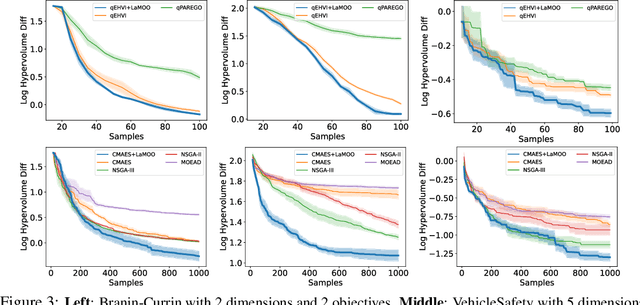
Abstract:In contrast to single-objective optimization (SOO), multi-objective optimization (MOO) requires an optimizer to find the Pareto frontier, a subset of feasible solutions that are not dominated by other feasible solutions. In this paper, we propose LaMOO, a novel multi-objective optimizer that learns a model from observed samples to partition the search space and then focus on promising regions that are likely to contain a subset of the Pareto frontier. The partitioning is based on the dominance number, which measures "how close" a data point is to the Pareto frontier among existing samples. To account for possible partition errors due to limited samples and model mismatch, we leverage Monte Carlo Tree Search (MCTS) to exploit promising regions while exploring suboptimal regions that may turn out to contain good solutions later. Theoretically, we prove the efficacy of learning space partitioning via LaMOO under certain assumptions. Empirically, on the HyperVolume (HV) benchmark, a popular MOO metric, LaMOO substantially outperforms strong baselines on multiple real-world MOO tasks, by up to 225% in sample efficiency for neural architecture search on Nasbench201, and up to 10% for molecular design.
CompilerGym: Robust, Performant Compiler Optimization Environments for AI Research
Sep 17, 2021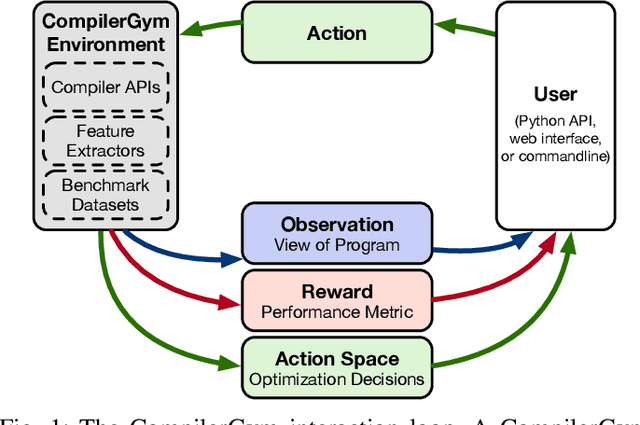
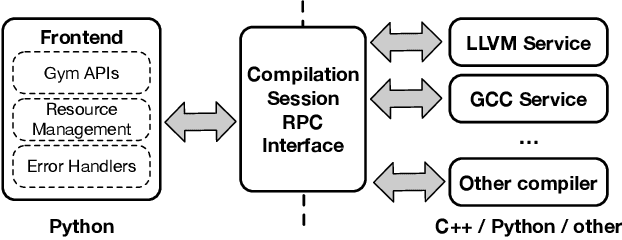
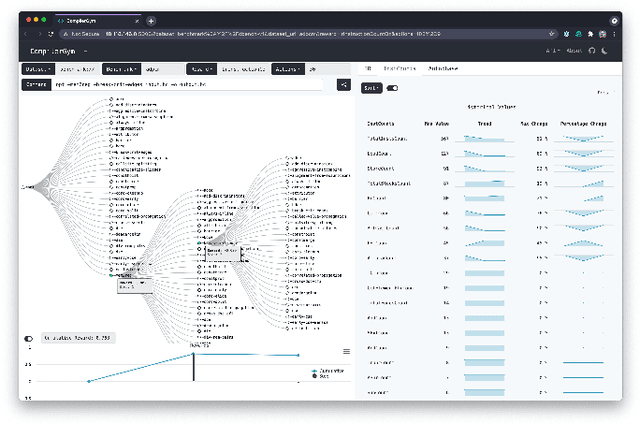
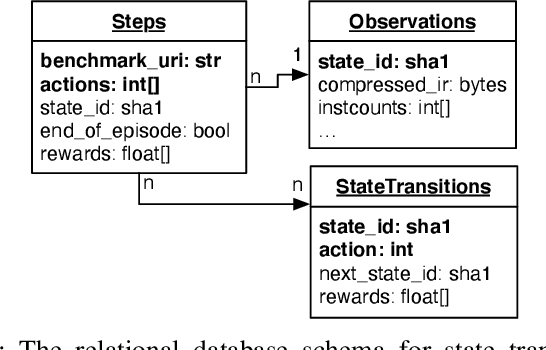
Abstract:Interest in applying Artificial Intelligence (AI) techniques to compiler optimizations is increasing rapidly, but compiler research has a high entry barrier. Unlike in other domains, compiler and AI researchers do not have access to the datasets and frameworks that enable fast iteration and development of ideas, and getting started requires a significant engineering investment. What is needed is an easy, reusable experimental infrastructure for real world compiler optimization tasks that can serve as a common benchmark for comparing techniques, and as a platform to accelerate progress in the field. We introduce CompilerGym, a set of environments for real world compiler optimization tasks, and a toolkit for exposing new optimization tasks to compiler researchers. CompilerGym enables anyone to experiment on production compiler optimization problems through an easy-to-use package, regardless of their experience with compilers. We build upon the popular OpenAI Gym interface enabling researchers to interact with compilers using Python and a familiar API. We describe the CompilerGym architecture and implementation, characterize the optimization spaces and computational efficiencies of three included compiler environments, and provide extensive empirical evaluations. Compared to prior works, CompilerGym offers larger datasets and optimization spaces, is 27x more computationally efficient, is fault-tolerant, and capable of detecting reproducibility bugs in the underlying compilers. In making it easy for anyone to experiment with compilers - irrespective of their background - we aim to accelerate progress in the AI and compiler research domains.
Learning Space Partitions for Path Planning
Jul 14, 2021



Abstract:Path planning, the problem of efficiently discovering high-reward trajectories, often requires optimizing a high-dimensional and multimodal reward function. Popular approaches like CEM and CMA-ES greedily focus on promising regions of the search space and may get trapped in local maxima. DOO and VOOT balance exploration and exploitation, but use space partitioning strategies independent of the reward function to be optimized. Recently, LaMCTS empirically learns to partition the search space in a reward-sensitive manner for black-box optimization. In this paper, we develop a novel formal regret analysis for when and why such an adaptive region partitioning scheme works. We also propose a new path planning method PlaLaM which improves the function value estimation within each sub-region, and uses a latent representation of the search space. Empirically, PlaLaM outperforms existing path planning methods in 2D navigation tasks, especially in the presence of difficult-to-escape local optima, and shows benefits when plugged into model-based RL with planning components such as PETS. These gains transfer to highly multimodal real-world tasks, where we outperform strong baselines in compiler phase ordering by up to 245% and in molecular design by up to 0.4 on properties on a 0-1 scale. Code is available at https://github.com/yangkevin2/plalam.
Latent Execution for Neural Program Synthesis Beyond Domain-Specific Languages
Jun 29, 2021

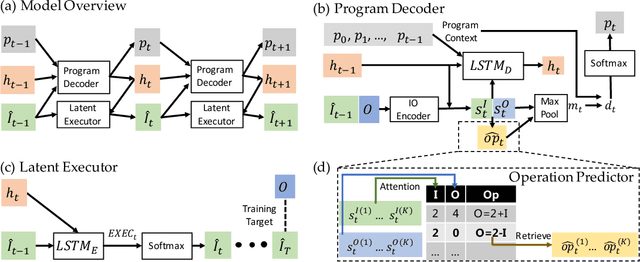
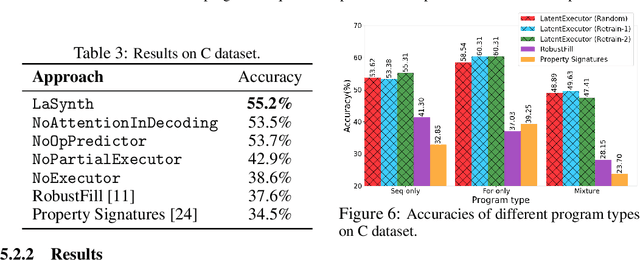
Abstract:Program synthesis from input-output examples has been a long-standing challenge, and recent works have demonstrated some success in designing deep neural networks for program synthesis. However, existing efforts in input-output neural program synthesis have been focusing on domain-specific languages, thus the applicability of previous approaches to synthesize code in full-fledged popular programming languages, such as C, remains a question. The main challenges lie in two folds. On the one hand, the program search space grows exponentially when the syntax and semantics of the programming language become more complex, which poses higher requirements on the synthesis algorithm. On the other hand, increasing the complexity of the programming language also imposes more difficulties on data collection, since building a large-scale training set for input-output program synthesis require random program generators to sample programs and input-output examples. In this work, we take the first step to synthesize C programs from input-output examples. In particular, we propose LaSynth, which learns the latent representation to approximate the execution of partially generated programs, even if their semantics are not well-defined. We demonstrate the possibility of synthesizing elementary C code from input-output examples, and leveraging learned execution significantly improves the prediction performance over existing approaches. Meanwhile, compared to the randomly generated ground-truth programs, LaSynth synthesizes more concise programs that resemble human-written code. We show that training on these synthesized programs further improves the prediction performance for both Karel and C program synthesis, indicating the promise of leveraging the learned program synthesizer to improve the dataset quality for input-output program synthesis.
MADE: Exploration via Maximizing Deviation from Explored Regions
Jun 18, 2021
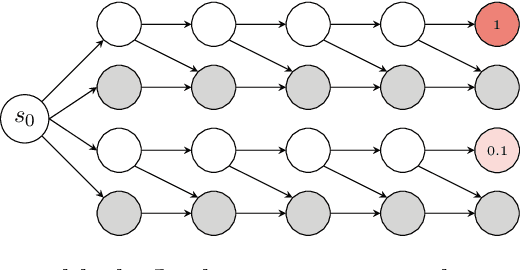


Abstract:In online reinforcement learning (RL), efficient exploration remains particularly challenging in high-dimensional environments with sparse rewards. In low-dimensional environments, where tabular parameterization is possible, count-based upper confidence bound (UCB) exploration methods achieve minimax near-optimal rates. However, it remains unclear how to efficiently implement UCB in realistic RL tasks that involve non-linear function approximation. To address this, we propose a new exploration approach via \textit{maximizing} the deviation of the occupancy of the next policy from the explored regions. We add this term as an adaptive regularizer to the standard RL objective to balance exploration vs. exploitation. We pair the new objective with a provably convergent algorithm, giving rise to a new intrinsic reward that adjusts existing bonuses. The proposed intrinsic reward is easy to implement and combine with other existing RL algorithms to conduct exploration. As a proof of concept, we evaluate the new intrinsic reward on tabular examples across a variety of model-based and model-free algorithms, showing improvements over count-only exploration strategies. When tested on navigation and locomotion tasks from MiniGrid and DeepMind Control Suite benchmarks, our approach significantly improves sample efficiency over state-of-the-art methods. Our code is available at https://github.com/tianjunz/MADE.
 Add to Chrome
Add to Chrome Add to Firefox
Add to Firefox Add to Edge
Add to Edge